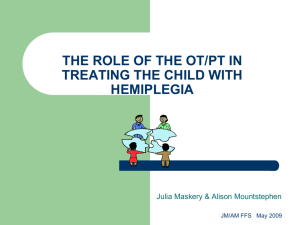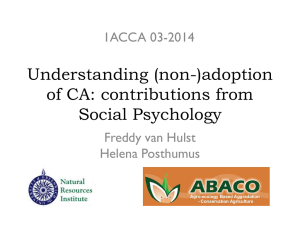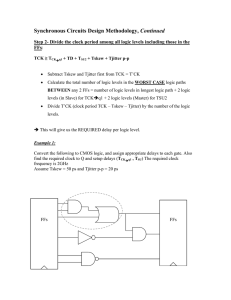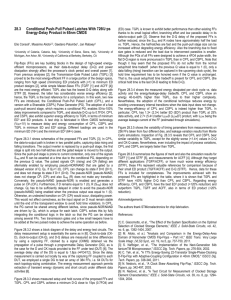JVGA/DDD Rate-Setting Slide Presentation
advertisement
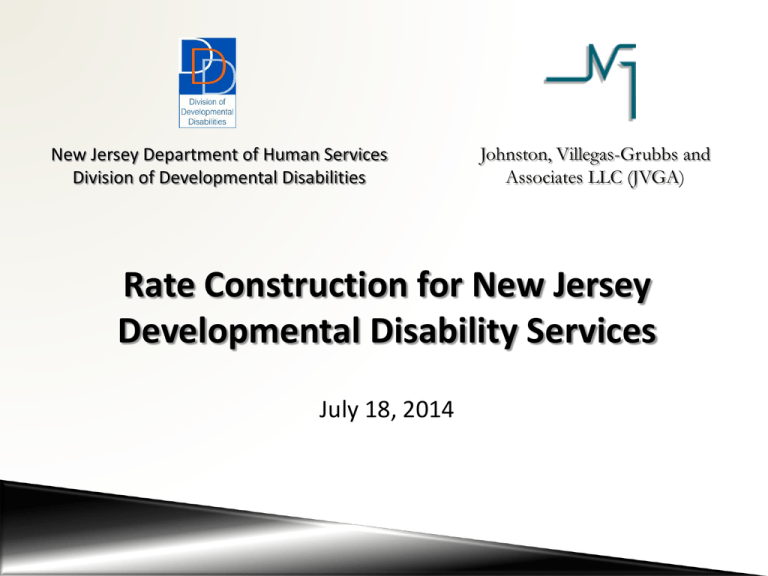
New Jersey Department of Human Services Division of Developmental Disabilities Johnston, Villegas-Grubbs and Associates LLC (JVGA) Rate Construction for New Jersey Developmental Disability Services July 18, 2014 Agenda • 10:00 am - 12:00 pm • Welcome and Acknowledgements – Elizabeth M. Shea, Assistant Commissioner, NJ Division of Developmental Disabilities • Rate Setting Presentation – JVGA Team – Thomas Papa, Chief of Staff, NJ Division of Developmental Disabilities • Submission of Questions • 12:00 pm – 1:30 pm • Lunch Break • 1:30 pm – 3:00 pm • Review of Questions 2 The Conversion to Fee for Service: Key Questions • • • • • • Why are we converting to Fee for Service (FFS)? Why do we need a standard rate schedule? How will FFS work? How does FFS fit in with the other reforms? When will the conversion to FFS take place? What else needs to happen to implement FFS? 3 Principals of Rate Architecture • • • • • Fairness and Equity Portability Affordability Reform Simplicity and Practicality 4 The Rate Setting Project: Background • • • • • Role of Advisory Committees Role of Other Stakeholders Data Collection and Analysis: GLs and Calls The Committee Meetings Budget Work 5 Basis of the Rate: Four Components of “THE BRICK”™ 1. Direct Care Staff Wage Staff time to deliver service (based on BLS assumption inflated to January 2015) • The BLS category chosen varies by service and provides the basis of each rate as closely as possible 6 Basis of the Rate: Components of “THE BRICK”™ 2. Employment-Related Expenditures Combination of discretionary (health benefits, retirement, etc.) and non-discretionary costs (unemployment, social security, workers compensation, etc.) • Each General Ledger provided to JVGA was analyzed to arrive at a 39% factor 7 Basis of the Rate: Components of “THE BRICK”™ 3. Program Support Expenditures needed to support consumers that are not assignable to a single consumer (supplies, supervision, equipment, training) • These percentages vary by service • Acuity differentiated rates may have higher Program Support percentages due to the increased need for staff supervision • Training & staff recruitment costs were included in this component based on Committee recommendations (as opposed to G/A) 8 Basis of the Rate: Components of “THE BRICK”™ 4. General and Administrative (G/A) – Costs of doing business that are common across all industries (Legal and Accounting, Administrative salaries, etc.) – G/A is calculated as a percentage of the cumulative total of Direct Care Staff Wage, Employment Related Expenditures and Program Support • An analysis of the current DDD provider inventory indicates that, on average, G/A is being applied at 10.5% • In most federal programs, G/A is typically applied in the 10% range • Based on input from the Advisory Committees and other stakeholders, JVGA recommends a 12% G/A factor in the rate structure. 9 Developmental Disability Services: Rates • Scope of work included all DDD waiver services – both Community Care Waiver and Supports Program • The only exception is the CCR model • Services fall into four categories – – – – Existing and Re-engineered services New Services Services still under construction Services where there is no standard rate to be set 10 Developmental Disability Services: Service Categories for Rate Construction 1. Existing and Re-engineered Services • Day Habilitation, Respite, Individual Supports, Supported Employment, Support Coordination 2. New Services • Behavioral Supports, Career Planning, Cognitive rehabilitation Therapy, Community Based Supports, Community Inclusion, Interpreter Services, Physical Therapy, Prevocational Training, Speech Therapy 11 Developmental Disability Services: Service Categories for Rate Construction 3. Services that are still under construction • Transportation, Supports Brokerage 4. Services where there is no standard rate to be set • Assistive Technology, Case Management, Community Transition Services, Environmental Modifications, Fiscal Intermediary, Goods and Services, Natural Supports Training, PERS, Vehicle Modifications 12 The Rate Sheet • Walk Through There are different rate structures The billable unit also needs to be considered 13 Other Key Assumptions Related to the Rate Setting Project • Demographic Differential • Studied the need for differentials based on geographic characteristics, size of provider, and offsets. • JVGA concluded that one standard rate can be used statewide and ensured that these issues were factored into the sample 14 Other Key Assumptions Related to the Rate Setting Project • Acuity Differential • Studied the need for an acuity differential to account for the higher costs associated with serving individuals with significant medical and/or psychiatric needs • This differential is only applied in cases where specialized staff, usually with higher credentials, is necessary based on assessment • Application of the differential is used to address the need for a higher level of a particular service, not more staffing hours 15 Other Key Assumptions Related to the Rate Setting Project • Housing • Current contract funding (~$75M) was set aside • Approach will be two-fold: – Existing residential placements - combination of (1) Service Funding (FFS, rate model), (2) Contribution to Care (SS, through rep payee), and possibly (3) DHS housing subsidy (used to help bridge gaps) – New placements - long-term goal is to collaborate with the community to build a housing model that is sustainable and can be supported via Service Funding and Contribution to Care • With rates now available for modeling, this will be an area of immediate discussion with the community and the new DHS Housing Unit (to determine both process and criteria around any potential use of subsidy) 16 Other Key Assumptions Related to the Rate Setting Project • Transportation • For licensed settings (GH, SA), the value of transportation has been added as a factor to the Individual Supports rate – Transportation needs will be met by residential provider, except where transportation is factored into the rate for another service • For all others, transportation will be billed primarily on a mileage reimbursement model • Parking and tolls included • Further discussion is needed 17 Other Key Assumptions Related to the Rate Setting Project • Respite • There are significant variations in this service within our current system • Service definitions and provider qualifications between waiver programs will be aligned • Further collaboration with families and providers will be needed to line up current programs and services with the upcoming FFS model • Reminder: CCRs not included in this rate project • Important takeaway: There is no habilitation component in respite 18 Other Key Assumptions Related to the Rate Setting Project • Self Hires • Need to finalize list of services for which self hires will be an option • Rates are equal but components of rate will need to be utilized to compensate the FI • RFP for DHS FI issued 6/23/14; bidding closes 8/12/14 19 Key Recommendations with Stakeholder Input • • • • • • • • • Individual Supports (Blocking) Self Hires Transition Period / Banding the Loss G/A Training & Recruitment costs Inflation adjustment of BLS wage assumptions (2015) Parking and tolls included in transportation rate 5% Absence Factor Acuity Levels* 20 Future Rate Influences • Data collection/utilization – As data improves, the system improves • Advocacy – Transparency = opportunities • Affordable Care Act (ACA) – There are some things that we know can happen but we cannot measure their effect 21 Final Decisions • Blocking Assumptions • Transition Period / Banding the Loss • Components of the Brick • • • • BLS Assumptions (including inflation adjustment) ERE Program Support % General and Administrative % 22 Upcoming Discussions • • • • • • Housing policies and licensing regulations NJCAT Crosswalk: Service Access & Acuity Factor Out of Program Days Transportation Respite Supports Brokerage 23 Using Rates in a Fee for Service System • What does it mean For Providers For Families For Consumers 24 Wrap-Up and Next Steps • Timeline / FFS Implementation Schedule – Upcoming Policy meetings – Webinars / Stakeholder conference calls • A FFS dedicated web page and Helpdesk will be in place beginning in August 2014. 25 26

